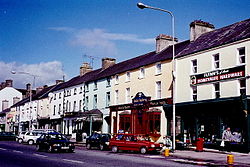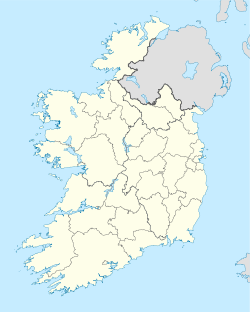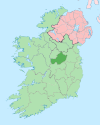- Moate
-
Moate
An Móta— Town — Moate Main Street Location in Ireland Coordinates: 53°23′42″N 7°42′58″W / 53.395°N 7.716°WCoordinates: 53°23′42″N 7°42′58″W / 53.395°N 7.716°W Country Ireland Province Leinster County County Westmeath Dáil Éireann Westmeath Elevation 72 m (236 ft) Population (2006)[1] – Total 1,888 Irish Grid Reference N182383 Moate (Irish: An Móta) is a town in County Westmeath, Ireland.
The name An Móta is derived from the term motte-and-bailey as the Normans built an example of this type of fortification here. The earthwork is still visible behind the buildings on the main street.
The town later became an important marketplace and Quaker village. There are several extant examples of Quaker houses on the main street, which itself is typical of an Irish marketplace (similar example in Ballymahon, County Longford).
Contents
Location
The town is on the R446 road between Kinnegad and Athlone. Before July 2008, this was the N6 road, a national primary route and Moate was a serious traffic bottleneck. The new M6 motorway bypasses the town. A disused railway line runs through the town. Built by the Midland Great Western Railway to connect Dublin and Galway which is now served by the Irish Rail route). Athlone lies 12 km west, along the N6.
Moate is a growing town with many new businesses including a supermarket (SuperValu), hardware store, an internet café-computer shop, a pizzeria, a petrol station, a pub, a post office, a credit union, a library, a hair dresser, a bank, a sport shop, a hotel and over twelve public houses. It has been the site of many new building ventures in recent years; for example, at the site of the old convent there now stands a complex of apartments and shops.
Culture and heritage
The town has a long established Gaelic Football club known as the Moate All Whites (the team plays in white strip). The club's name and colour are based on the colour of the religious habits worn by the Carmelite White Friars, a long established Moate institution.
Moate has a strong musical tradition with many young bands emerging from the town. There is also a recording studio.
The town's theatre and arts centre is called Tuar Ard and was once the site of St. Patrick's Hall, yet another national school for a time. It is now a venue for plays, seminars, classical and rock concerts, and presentations.
The Dún na Sí heritage centre on the west side of town includes County Westmeath's genealogy centre, a restaurant, recreations of various types of indigenous dwellings, and preserved farm machinery.
The former gaol, part of the old courthouse, now contains a small museum housing artefacts found in the area dating from the Stone Age through to the modern era.
Transport
- Moate railway station opened on 1 August 1851, closed for goods traffic on 2 December 1974 and closed for passenger traffic on 27 January 1987.[2]
- The town is well served on bus routes with the Bus Éireann number 20 bus going every two hours towards both Dublin and Galway.
Education
Moate has two primary schools, St. Brigid's National School (co-educational) and St. Oliver Plunkett Boys' Primary School.
The principle secondary school in the town is Moate Community School, which opened a new building in 2002 containing a gymnasium, four new science laboratories, a home economics room, art room, lecture hall, technical drawing classroom and an oratory as well as general classrooms and offices. It has approximately 1,000 students (including Moate Business College) and a staff of 72. Moate Business College, which is a PLC college, provides courses including performance arts and information technology.
Patrick Kelly Memorial Park
In December 2008 a memorial park was opened in Moate, named after the only Irish soldier to die in combat on home soil since the end of the Irish Civil War. On 16 December 1983, Patrick Kelly, who was from Moate, was attempting to free American businessman Don Tidey, who had been kidnapped by the IRA. Along with Garda recruit Gary Sheehan, he was killed in a shoot-out with Provisional IRA gunmen at Derrada Woods, Ballinamore, Co Leitrim.[3]
Film: The First Great Train Robbery
Parts of the film The First Great Train Robbery (1979)[4] starring Sean Connery and Donald Sutherland were filmed on the railway near Moate, and the train station depicted as Ashford is actually Moate station.
Famous People
- Nuala Holloway - Michael O'Connor - Daragh Ownes
See also
References
- ^ "Census 2006 – Volume 1 – Population Classified by Area" (PDF). Central Statistics Office Census 2006 Reports. Central Statistics Office Ireland. April 2007. http://www.cso.ie/census/documents/census2006_volume_1_pop_classified_by_area.pdf. Retrieved 2011-06-23.
- ^ "Moate station". Railscot - Irish Railways. http://www.railscot.co.uk/Ireland/Irish_railways.pdf. Retrieved 2007-11-04.
- ^ Article in Irish Times, page 3, 2008-12-17, by Ronan McGreevy": "Town Honours murdered soldier"
- ^ The Internet Movie Database (IMDB) - http://www.imdb.com/title/tt0079240/locations
Places in County Westmeath Towns and
villages- Athlone
- Ballinahown
- Ballykeeran
- Ballymore
- Ballynacargy
- Castlepollard
- Castletown-Geoghegan
- Clonmellon
- Collinstown
- Coole
- Crookedwood
- Delvin
- Drumcree
- Drumraney
- Finnea
- Fore
- Glassan
- Horseleap
- Kilbeggan
- Killucan and Rathwire
- Kinnegad
- Milltownpass
- Moate
- Mount Temple
- Moyvoughly
- Mullingar
- Multyfarnham
- Raharney
- Rathconrath
- Rathowen
- Rochfortbridge
- Rosemount
- Streamstown
- Street
- Tang
- Tubberclare
- Tyrrellspass
Baronies - Brawny
- Clonlonan
- Corkaree
- Delvin
- Farbill
- Fartullagh
- Fore
- Kilkenny West
- Moyashel and Magheradernon
- Moycashel
- Moygoish
- Rathconrath
- List of townlands in County Westmeath
- Category:Geography of County Westmeath
Categories:- Towns and villages in County Westmeath
Wikimedia Foundation. 2010.



